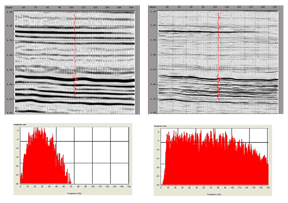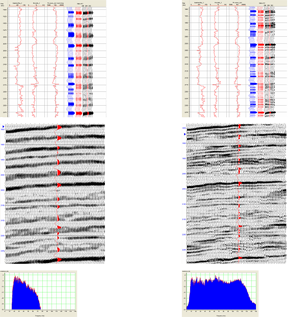Bandwidth Extension (BE®)
Widess and others have demonstrated that changes in phase and amplitude are evidenced in seismic as a result of beds that are below resolution. Geotrace has developed an algorithm, Bandwidth Extension (BE®), to recover that information more effectively than has ever been done.
BE® utilizes the Continuous Wavelet Transform (CWT) to perform a time series analysis of the seismic trace that decomposes the trace into its respective amplitude and phase components in both frequency and time. The trace is optimized in terms of resolution; the uncertainty principle states that we cannot know the exact frequency at the exact time anywhere in the spectrum. But in the low end of the spectrum frequency resolution is more important than time resolution and at the high end of the spectrum just the opposite is true. Fortunately the CWT provides us information in just that form. The product of the standard deviation of time and frequency in the CWT is a constant throughout the spectrum making it a very apt medium by which to do our work. Using the fundamental frequencies at our disposal we predict their harmonics to extend the upper end of the spectrum and sub-harmonics to extend the lower end. If there is reflectivity present in the data that corresponds to the harmonic frequencies it will remain in the result. Any harmonic or sub-harmonic frequencies that do not correspond to reflectivity in the data fall out of the spectrum. The result is both broader band and more accurate than conventional methods such as whitening, well calibration whitening and colored inversion.
So how much difference can BE® make? In some cases we have seen up to two octaves at each end of the spectrum. But are the extended frequencies real? In order to verify the accuracy of such predictions it is standard to compare the well log synthetic seismograms and correlation of extracted amplitudes to known geology.
Interpreters using the high-resolution data are often surprised they can see obvious amplitude differences between a good and a poor reservoir after BE® has been applied.















